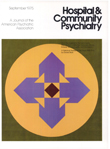Adopting New Models for Continuity of Care: The Ward as Mini-Mental-Health-Center
Abstract
Several years ago the staff of a traditional psychiatric ward in a Veterans Administration hospital began trying to provide continual care for their former inpatients after they left the hospital. Nursing assistants conducted basic-skills groups and other groups in board-and-care homes; staff members made themselves available to former inpatients and their families, room-mates, or board-and-care sponsors through a 24-hour telephone service and home visits; and a day-care program and follow-up groups for the ward's outpatients were set up. Later the staff established additional day-care and follow-up programs in a down-town satellite unit. In a recent three-month period, patients made a total of 4488 visits to the satellite and hospital programs. The preceding paper discusses some of the theoretical considerations on which this program and other alternatives to traditional care are based.
Access content
To read the fulltext, please use one of the options below to sign in or purchase access.- Personal login
- Institutional Login
- Sign in via OpenAthens
- Register for access
-
Please login/register if you wish to pair your device and check access availability.
Not a subscriber?
PsychiatryOnline subscription options offer access to the DSM-5 library, books, journals, CME, and patient resources. This all-in-one virtual library provides psychiatrists and mental health professionals with key resources for diagnosis, treatment, research, and professional development.
Need more help? PsychiatryOnline Customer Service may be reached by emailing [email protected] or by calling 800-368-5777 (in the U.S.) or 703-907-7322 (outside the U.S.).



